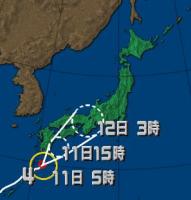Japan is knowingly struck by an impressive variety of what we call “natural disasters”:
Earthquakes, volcanic blasts, tsunami, etc. Among these phenomena (to which many japanese are getting used to), one should not forget to mention typhoons. These violent tropical hurricanes are causing trouble to many japanese, especially during the month of September. September could be called the month of typhoons in Japan.
In Japanese, a typhoon is called taifuu (台風 ou 颱風) -the pronounciation is quite similar to English (without the final “n”), and you probably won’t be surprized to hear that  this word contains the kanji (ideogram) 風 which means “wind”. Most typhoons are born in the far South of Japan (nearby Okinawa island or even more South), and make their way up North hour after hour, along the East coast. Therefore, inhabitants of northern Japan are safer than southern japanese. This is due to the fact that many typhoon heading north do not necessarily reach Hokkaidô, many of them dying in the ocean on the way.
this word contains the kanji (ideogram) 風 which means “wind”. Most typhoons are born in the far South of Japan (nearby Okinawa island or even more South), and make their way up North hour after hour, along the East coast. Therefore, inhabitants of northern Japan are safer than southern japanese. This is due to the fact that many typhoon heading north do not necessarily reach Hokkaidô, many of them dying in the ocean on the way.
Japanese do of course a lot of research to try predicting typhoons appearance and behavior, and it is not rare that they are among top news, especially at the end of the summer. Instead of giving them names, the Japanese assign a number to each typhoon, following their chronological order of appearance. “Typhoon number 16 is currently located above Okinawa and heading…”